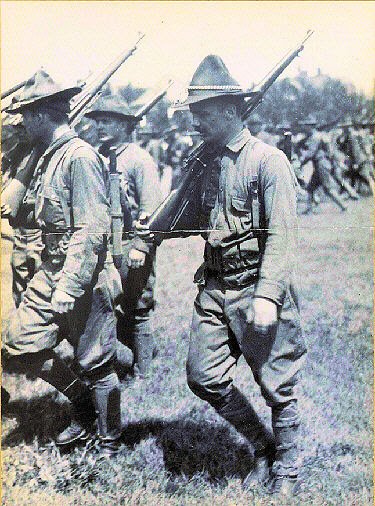United States Inadequate Preparations for World War I
We covered the United States preparedness for World War II in a previous post. Although The United States may not have been prepared for Japan's surprise attack on Pearl Harbor, December 7, 1941, it was prepared for war.
What about World War I? It started in August 1914, and the United States entered the war two and a half years later, April 1917. Was the United States, under President Woodrow Wilson, ready when it entered the war in 1917?
Background
World War I broke out in August 1914. Germany, Austria-Hungary, and Turkey (the 'Central Powers') faced Russia, France, Italy, and Great Britain (the 'Allied Powers'). The war rapidly stalemated, with considerable casualties on both sides. The United States remained neutral.
As the war continued into 1916, former President Theodore Roosevelt and others felt that the United States needed better military preparations to improve its defenses in case of attack. Also they thought the U.S. should be ready in case it became involved in the war. The United States military was tiny at that time. The Army had under 150,000 soldiers. For comparison, the Central and Allied powers were fielding armies of over 10,000,000 soldiers. Similarly, the Navy was smaller than the combatants.
This movement, known as the Preparedness Movement, resulted in a series of voluntary training camps based in Plattsburg, NY. Over 40,000 men volunteered for training. They had to pay their own expenses. Most of the attendees were College Graduates and affluent. Several of Teddy Roosevelt’s sons attended the camps. When the U.S. entered the war in 1917, many of its officers came from this movement.
In response to political pressure and the continuing war in Europe, President Wilson worked with Congress on two bills that moderately increased the military.
Naval Act of 1916
The goal of this bill was to build the largest Navy in the world over 10 years. With that slow timeframe, very few additional ships were available when the U.S. entered the war in April 1917.
National Defense Act of 1916
This act called for a doubling in the size of the Army over several years. Since the United States was starting with a tiny army, doubling its size still would leave it with a significantly smaller army than any of the combatants.
Entry into the War - 1917
When the war started in 1914, Britain imposed a naval blockade against Germany, preventing Germany from importing needed supplies, including from neutral America. In response, Germany tried to blockade Great Britain using its submarine force. However, submarines' only option was to sink merchant ships. Before February 1917, German submarines would warn freighters, giving the crews a chance to get into lifeboats. This reduced the effectiveness of the German attempted submarine blockade. In February 1917, Germany started unrestricted submarine warfare, sinking ships without warning, including neutral American merchant ships. This turned American opinion against Germany.
Also, in February 1917, British cryptographers presented a deciphered a telegram from German Foreign Minister Zimmermann to Mexico. This message offered United States territory to Mexico in return for joining the German cause.
These two factors, unrestricted submarine warfare, and the Zimmerman telegram, led to President Wilson's declaration of war request, approved by Congress in April 1917.
American Role in the Fighting
Despite the National Defense Act of 1916, the United States Army was not prepared to fight. As described in the official army military history:
"Both the country and the Army were absolutely unprepared for what was going to happen. The United States had no process in place to build a mass army, supply it, transport it and fight it…Building an army takes more than just opening recruiting stations. Soldiers needed barracks, training areas, uniforms, and equipment, as well as a steady supply of recruits…Equipment was another bottleneck. The first troops showed up and trained with wooden rifles. There were delays in getting uniforms and boots. Heavy equipment or weapons? Nope."
As a result, it took over a year before the United States could significantly participate in any ground fighting. Their first major engagement was the Battle of the Marne in June 1918. After that, the U.S. was a significant contributor to the battles that led to the end-of-the-war in November 1918.
Franklin Delano Roosevelt (FDR) and World War I
FDR as Assistant Secretary of the Navy, 1913
FDR admired Teddy Roosevelt, the uncle of Eleanor, his wife. Teddy served as Assistant Secretary of the Navy back in the 1890s, a role that advanced his career in politics. Following in Teddy's footsteps, FDR served in the same role, Assistant Secretary of the Navy under President Wilson. He saw how unprepared the United States was when it entered World War I. That may have been one motivation behind FDR's war preparations before U.S. entry into World War II.
A Near Run Thing
After the Duke of Wellington won the battle of Waterloo against Napolean, he commented that 'it was the nearest run-thing.' He meant the battle was so close it could have gone either way.
World War I was a 'near run thing.' In 1917, the Central Powers were ascendant. The Bolshevik Revolution in Russia overthrew the Tsar's government, eventually leading to Russia's withdrawal from the war. The French Army mutinied in the Spring of 1917, refusing to participate in any more fruitless offensive campaigns. Italy nearly collapsed after a major defeat in the battle of Caporetto.
Although American entered the war in 1917, it was not ready to provide significant ground force assistance for over a year. Germany, sensing a chance to win before American troops showed up in numbers, transferred freed up troops from the Russian front to the Western Front in France. Germany launched a final offensive in March 1918. The offense experienced significant success and broke the British lines in places. Ultimately the offense bogged down by due to British and French resistance. American troops played a limited role in stopping the German offensive. However, by the summer of 1918 American forces started to arrive in significant numbers. The United States participated in the defeat of Germany, with an armistice declared on November 11, 1918.
How close did Germany come to victory in 1918? Closer than they would have had America been prepared in 1917. As it was, America's unpreparedness gave Germany an opportunity. And the United States ground forces were unable to materially help the Allied victory until late in the War.



